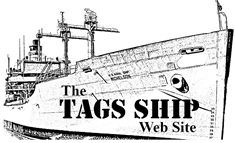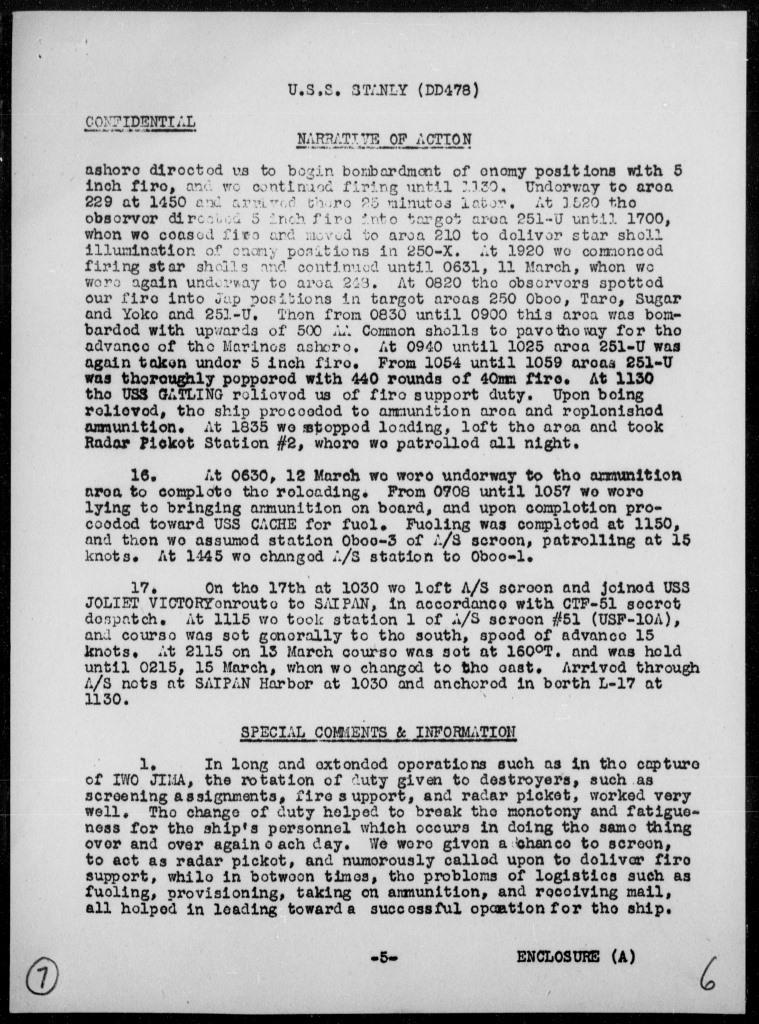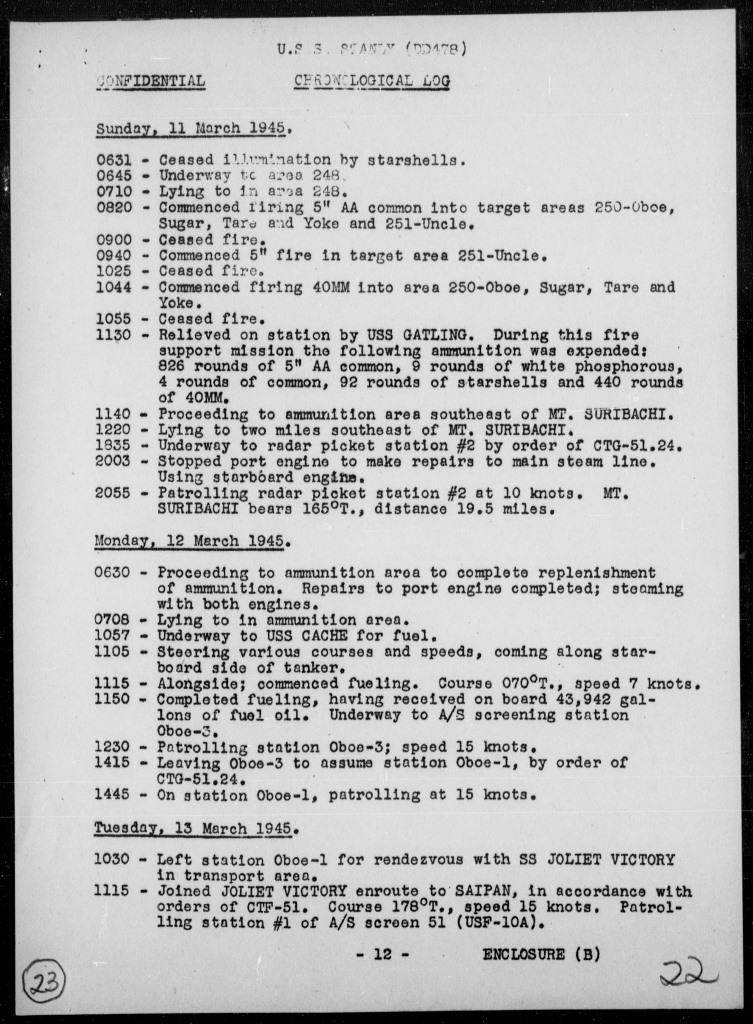The Diary of a Seaman Aboard SS Joliet Victory
A dealer in original manuscripts has for sale the diary of a merchant seaman who served aboard SS Joliet Victory in 1944. Below is a description of the diary from the dealer's website, shown here by editorial license.
1944 FASCINATING ORIGINAL HANDWRITTEN JOURNAL OF A HARD-DRINKING, SHORT-TEMPERED EVERYMAN, WORKING AS A CARPENTER ON THE SS JOLIET, WORKING HARD ON DUTY, DRINKING AND FIGHTING WHEN OFF
On offer is the fascinating 1944 diary of Walter Trent, a hard-drinking, tough carpenter on the SS Joliet [Victory] during World War 2.
Trent works on the ship, as it makes stops in the Mediterranean first, and then moves on to the Pacific theater of World War 2. This diary is a very interesting document of WW2 history, showing the tasks and life of a non-combat naval personnel during the war. Most of the longest entries in the diary are accounts of shore leave and downtime. These passages are where this document is most interesting. The diary shows the curious day-to-day events that transpired in the life of someone during war, as opposed to the specifics of combat or military campaigns. The diary is signed on the front page, “Walter W. Trent 320 N. Rosine Ave. Somerset, PA.” The diary is interesting in that each entry uses both the verso and recto of the whole page.
The first entry, spanning both the left and right page is dated June 4, 1944 and states, “Left N.Y.C. and went to Baltimore in the afternoon. Arrived and could not find a room in any hotel. Finally went to the Officer’s Club and got a room through them at Mr.s Florence Blades at 1220 Park Ave. Had a big front room and bath. Very nice place.” The next day, he joins the S.S. Joliet “to take coal to Naples, Italy.” He has a few days before he departs on the SS Joliet, so he returns to N.Y.C., takes a girl (possibly a girlfriend), Rose, out to dinner and dancing, then returns to Baltimore to depart on the ship.
On June 12, “Tuesday. Went aboard by 9 to find everybody had signed Articles Monday. So I went up to the Commissioners to sign on, while there it came up that there was no carpenter. So I signed on as A.B. with the understanding that if no carpenter signed by 1 P.M. that I got the job.” No carpenter signs and after the ship departs Baltimore, there are many entries of the carpenter tasks that Trent does. “Mad a towel rack for 2nd mate and started to grease the windlass and booms.”; “worked all day just on the doors cleaning and greasing them. Had to fix No. 1 storm batten because it had no turnbuckle.”
On July 1st, the SS Juliet arrives in Augusta, Sicily. On arrival, “there were bum boats around the ship all morning. Trying to buy cigarettes for $9.00 a carton American $. Soap went for 3 to 4 cakes a 100 Lira. A lira is worth 1¢. I swapped some soap for some Cognac. Received orders around 1030 AM to go to Naples, Italy for further orders.” He goes to Sicily and then soon to Gallipoli.
For the next month or so, Trent writes the tasks and odd carpentry jobs that he did around the boat, commenting that the crew always seems to be breaking everything. He swims often, talks about buying, selling, and swapping cigarettes, soap, booze, etc. From Gallipoli the ship moves to Naples, and then to Marseilles, France. At the end of July he goes to the sick bay with a fever and infection. He mentions soon after that he “went ashore and saw a girl about a dog in a house,” possibly a euphemism for using a prostitute.
By early August, his entries are rather short, including one “August 4. Saturday. Same old shit.” On August 14, he has his first entry directly related to the ongoing war. “Received and talking over the news it does not seem possible that peace is around the corner. 7 PM. My birthday and peace at last.”
The SS Joliet goes from the mediterranean, to Balboa spain, and then sails for the Philippines. Trent mostly works, but when he goes ashore, he seems to be quite the drinker and partier. “Went ashore after breakfast and met Foskey and Cavelsky had some drinks. Tried to go back to the ship but Leon was dragging some Tape that held a bottle and the guard turned him back. So went to a hotel and took a room. Went to to sleep till 4 P.M. woke up and drank the bottle. Went out and had some dinner. Went back to the ship around 11 P.M.”; “Had a terrible hangover and a slight stuttering around 3PM.”; “I woke up laying out in the jungle so weak that I could not move, until 10 AM when two (?) gave me some water and helped me to there came, shoes + watch gone.”
He also seems to have a bit of a mean streak to him as there are a few entries in which he speaks of quarrels and insubordination with the mates on the ship. On October 3, the ship lands in Lingayen Bay, in the Philippines. From Lingayen Bay the Joliet moves onto Eniwetok. “October 25, Thursday. Arrived at Eniwetok at 4:30 PM. It is a big lagoon surrounded by small islands of 1/2 mile size in a circle of 22 miles a lot of them are submerged. Before the war the Atoll had 130 people now there are 300,000 army, navy. There were around 200 ships, tankers & freighters and some navy. The main island was covered with buildings and only a few palm trees and was very hot.” The Philippines, Trent notes, is hot, musty, and awful. “A rainy day and I have Ring worms where I sit down and don't seem able to get rid of them. Everybody seems to have them or the jock itch between her legs.”
The SS Joliet is not long in the Philippines though. After their orders are completed, they make their way back to the U.S. On November 29, the SS Joliet arrives back in Miami. It’s a good thing too. The day before, on November 28, Trent writes, “Looked in my locker and found that my wallet was stolen with 18 dollars in. Damn it I will be glad to get off this god damned ship.” From Miami, the ship goes back to N.Y.C. Trent parties hard on December 3rd and stays out all night. The last entry of the diary is December 4th, and just says, “still out.”
(Background - Launched as the SS Joliet Victory in 1944, Maritime Commission hull number MCV 114, a type VC2-S-AP3 Victory ship. She served in the Pacific War, participating in the landings on Leyte in late 1944. SS Joliet Victory Naval Armed Guard crews earned Battle Stars in World War II for war action in during the Invasion of Lingayen Gulf from 4 Jan. 1945 to 18 Jan. 1945. Also a second "Battle Stars" for the Leyte landings in the Battle of Leyte from 5 March 1945 to 13 March 1945. Joliet Victory was active in delivering support for the Battle of Iwo Jima from 19 February to 26 March 1945. In each battle she had to use her deck guns to defend against air attacks. Joliet Victory and the SS Columbia Victory had the dangerous job of supplying artillery ammunition for the Iwo Jima battle. The ship was laid up in the Hudson River as part of the National Defense Reserve Fleet on 1 July 1948, and was reactivated during the Korean War, serving from 27 July 1950 until 31 October 1953, when she was again laid up in the NDRF in the James River. She was acquired by the U.S. Navy on 8 February 1958, renamed Michelson, and converted to an Oceanographic Survey Ship (AGS) at the Philadelphia Naval Shipyard.)





